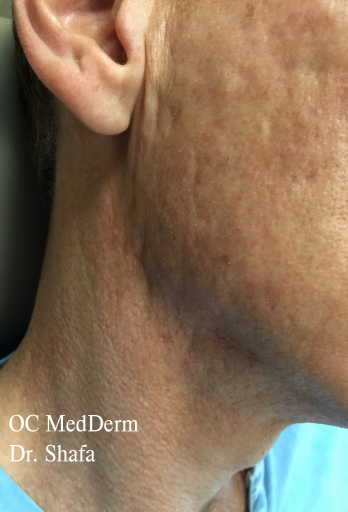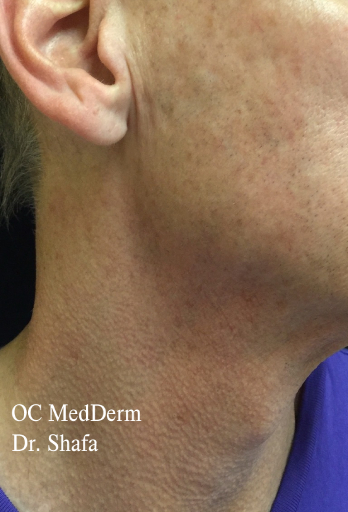Dr. Parvin Shafa | October 3, 2025


Chemical peels are non-surgical dermatological treatments that involve applying a chemical solution to exfoliate the outer layers of the skin. These procedures are designed to accelerate cell turnover, remove damaged skin, and stimulate new collagen production. Initially developed for general skin rejuvenation, chemical peels have evolved into targeted treatments for a wide range of conditions, including:
In the past decade, the use of chemical peels for acne-related concerns has become particularly popular. This is because many individuals seek treatments that are effective yet less invasive than laser or surgical methods. According to the American Academy of Dermatology, chemical peels remain among the top five most commonly performed non-invasive procedures in dermatology.
Dermatologist Dr. Shilpi Khetarpal of the Cleveland Clinic states, “Chemical peels offer a controlled way to resurface the skin and improve superficial to moderately deep acne scarring. When used appropriately, they can be very effective, especially in combination with other treatments.” At OC MedDerm, chemical peels are often recommended as part of a comprehensive approach to skin rejuvenation and acne scar management.
To understand the effectiveness of chemical peels for acne scars, it’s essential to first understand the types of acne scars:
Chemical peels help improve acne scars through several mechanisms:
In conclusion, while chemical peels cannot completely remove deep acne scars, they are highly effective for PIH and mild to moderate atrophic scarring.
Different acids and formulations target specific skin concerns. Here’s a detailed breakdown:
Pitted scars (ice-pick, boxcar, rolling) are structural deformities in the dermis and require collagen remodeling for visible improvement.
Dermatologist Dr. Davin Lim suggests, “Chemical peels should be part of a multi-modal treatment plan for atrophic acne scars. On their own, they’re good, but in combination, they deliver significantly better results.”
Costs vary based on region, peel type, and clinic reputation.
| Peel Type | US (USD/session) |
| Glycolic Acid | $100 – $150 |
| Salicylic Acid | $80 – $130 |
| TCA Peel | $150 – $300 |
| Jessner’s Peel | $100 – $250 |
| TCA CROSS | $100 – $200 |
| Phenol Peel | $600 – $1,200 |
Note: Multiple sessions (usually 4 to 8) are required for best results.
| Peel Depth | Downtime |
| Superficial | 2–4 days (redness, light flaking) |
| Medium | 5–7 days (peeling, swelling) |
| Deep | 10–14+ days (crusting, erythema) |
| Myth | Fact |
| Peels are only for fair skin | Superficial peels like lactic and salicylic acid are safe for darker skin tones |
| One peel is enough to remove scars | Multiple sessions and combo therapies are often necessary |
| All peels have the same effect | Peel strength, ingredients, and technique matter greatly |
| Peels thin the skin permanently | They actually thicken the dermis over time via collagen production |
| At-home peels are just as good | Professional peels use higher concentrations and controlled methods |
Chemical peels are a scientifically backed treatment for improving acne scars and pitted skin. Their ability to exfoliate, stimulate collagen, and reduce pigmentation makes them a cornerstone in dermatologic care for acne scarring. However, their success depends on proper peel selection, consistency, and often, combination with other therapies.
For best results:
Q1: Will chemical peel remove acne scars completely? No. While they significantly reduce pigmentation and improve texture, deep scars may need combination treatments like microneedling or lasers.
Q2: How long does it take to see results? Most patients notice improvements after 3–6 sessions spaced 2–4 weeks apart. Full results can take 3–6 months.
Q3: Are peels safe for darker skin tones? Yes, particularly superficial peels like salicylic or lactic acid. Deeper peels require professional oversight.
Q4: Are at-home peels effective? They may help with mild pigmentation but are not strong enough for scar treatment. Professional peels are more effective.
Q5: Can I combine peels with other treatments? Yes. Combining chemical peels with microneedling, subcision, or laser resurfacing often gives superior results, especially for pitted scars.
If you are ready to experience visible results and regain confidence in your skin, Irvine Skin and Laser is here to guide you. Our customized chemical peel treatments are designed with your comfort, safety, and results in mind. With expert care, professional-grade solutions, and a compassionate approach, we help you achieve the smooth radiant skin you deserve.
Book your consultation today at Irvine Skin and let us help you take the first step toward a scar-free future.
You are just one decision away from feeling confident in your skin again.
Book a consultation at OC Medderm | Irvineskin Today for Medical, Surgical, and Cosmetic Dermatology in Irvine & Orange County, CA.
We are experts in Acne, Pinch blepharoplasty, Ear lobe repair, Xanthelasma repair, Syringomas removal, mole removal, Keloid removal, Body and face piecing or piercing repair or removal, lump and bumps removal, Acne scar removal, Spider vein treatment, fungal infection, Co2 resurfacing, Warts and more.
You can schedule an appointment or call us now for all the dermatology treatments. We are located at 113 Waterworks Way 100, Irvine, Orange County CA, We Are Dedicated to Providing the Best & Transparent Dermatology Care for your skin.
Call us when you want!